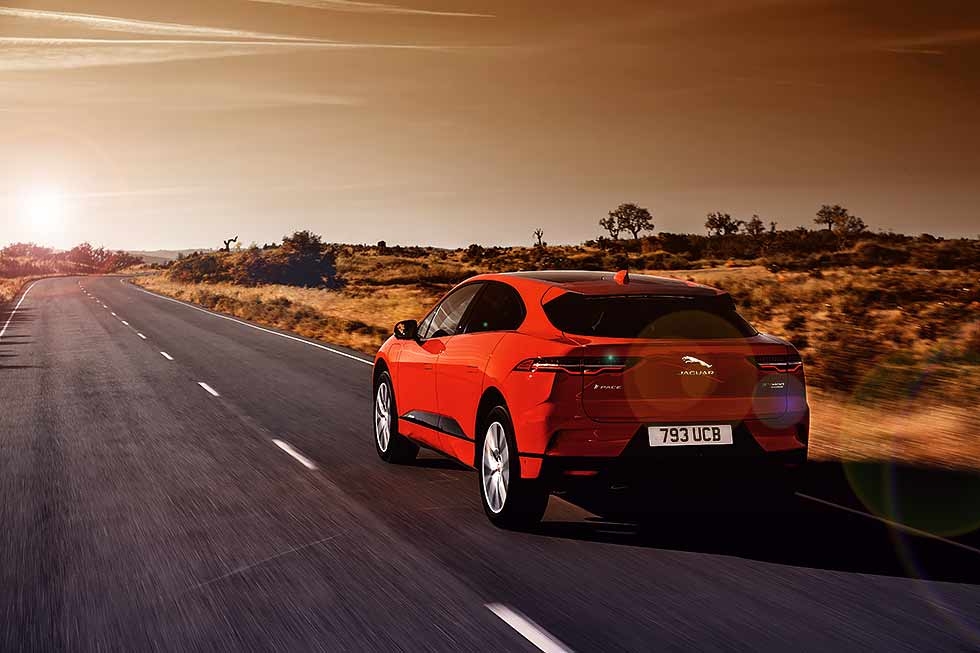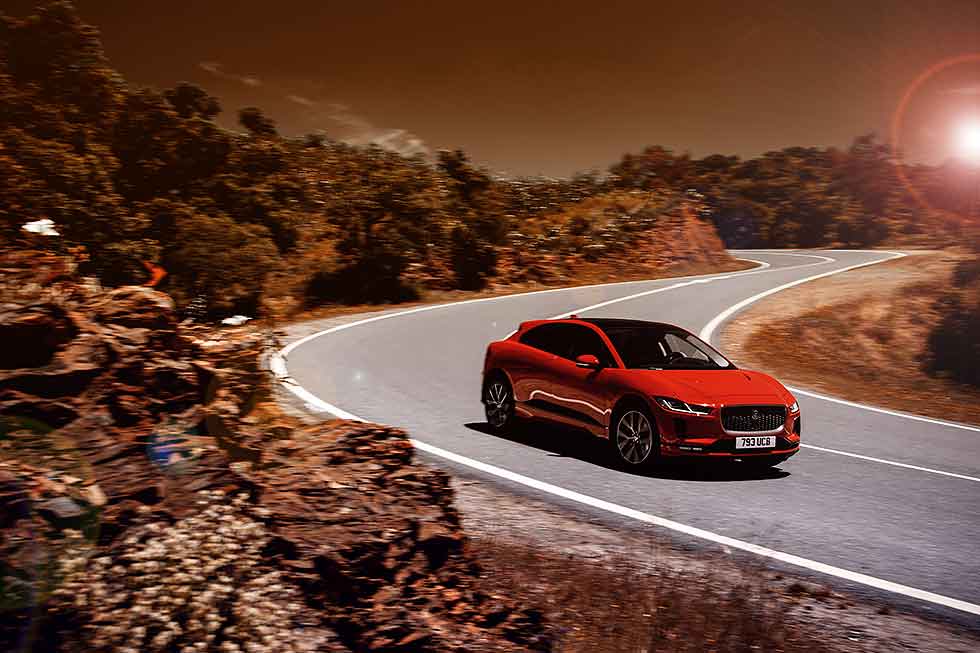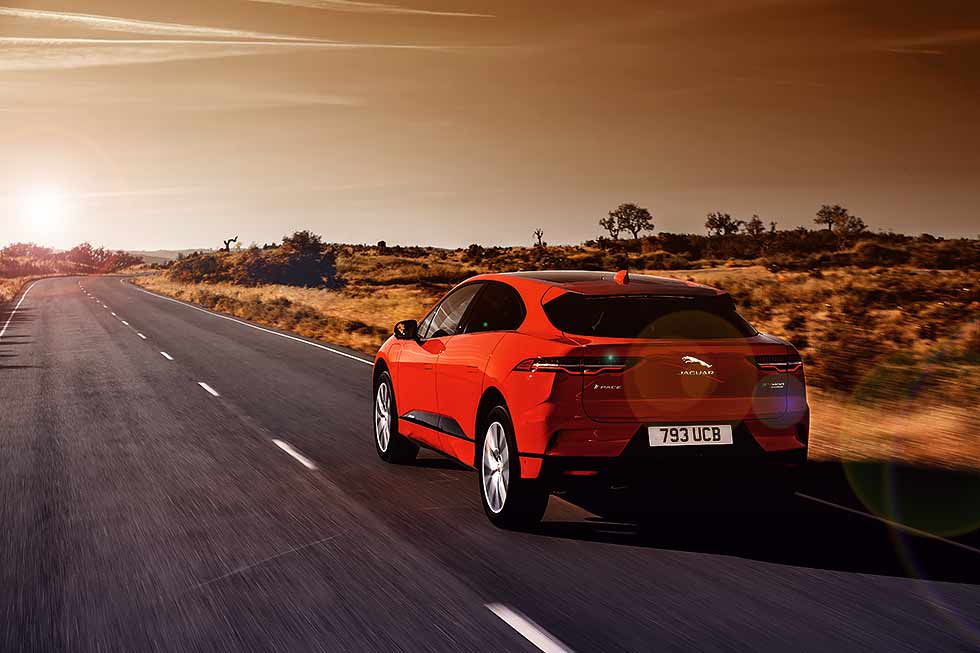
Setting the I-Pace. Arguably the most important Jaguar ever built, I-Pace is the company’s first electric car and its most ambitious yet. Hoping to capitalise on both the SUV and EV segment sales rise, Jaguar has high hopes this will become the standard bearer for generations of electric Jaguar to come. WORDS: Jonathan Musk & Photos: Drive-My EN.
First Drive: Jaguar I-Pace Our hotly anticipated first drive of the sensational Jaguar I-Pace – the Coventry firm’s first foray into electric power.
DRIVEN THE MOST IMPORTANT JAGUAR
With SUV sales predicted to hit 24.3 million by 2020 and the EV segment the fastest growing in the automotive industry, Jaguar has every confidence that an electric SUV should sell.

But first, it needs to convince the market that this is a vehicle worthy of worldwide appeal. Naturally, anyone au fait with electric vehicles will immediately point towards Tesla which has managed to gain global interest, if not always in the best light. Jaguar, on the other hand, is a company that has built its reputation and success on internal combustion. Of course, that is largely because petrol and diesel were the only power sources available for a long time.
Today, Jaguar is a very different and forward thinking animal that plans to electrify its fleet of vehicles by 2020, starting with the I-Pace. Having first experienced the I-Pace in development mule form, it’s an understatement to state that we were excited to give the production version a go. And, after 11,000 hours of rig testing, more than 1.5 million miles of test drives and 200+ prototype vehicles made, I-Pace is finally ready for market.

Let’s get technical…
Perhaps the most talked about aspect of any electric car (though it shouldn’t be) is range. There’s a 90kWh battery that offers 298 miles (480km) autonomy – and that’s WLTP rated, meaning it should be a far more realistic figure than the often nonsense NEDC might suggest. The battery can be charged in 13.9 hours using a 7kW home charge point, or as little as 15-minutes can provide 62 miles of range using a 100kW rapid charger – twice the power of current generation 50kW chargers (not that you’ll find any in the UK, yet).
I-Pace uses the Combined Charging Standard (CCS) and so benefits from being able to use any of the thousands of compatible rapid chargers around Europe.
The reality is that with a range of almost 300-miles, most owners will simply charge at home overnight and that’ll be that. They can head more than 100 miles away from home regularly, happy in the knowledge that the car will get them home – and without the need to fuss abut charging too. For those who wish to venture further, clearly, the I-Pace doesn’t offer quite the same level of luxury as that available from Tesla, with their proprietary Supercharger network. That said, once 100 or 150kW charge points become commonplace, I-Pace owners will benefit from a similar experience, albeit not likely free. Using CCS also means the I-Pace can use the Ionity network that’s being developed by Mercedes- Benz, Ford, BMW and Volkswagen Group, but will of course be limited to its maximum charge rate. Don’t expect Jaguar to update the car to use 350kW charging, however, as it would require a wholly new battery setup and electronics running at 800 volts to be able to do so.
Preconditioning of the battery when plugged into the mains can extend range by as much as 60 miles, counteracting the effect of cooler temperatures – important in Scandinavian countries, for example. What’s more, I-Pace is equipped with a heat pump that absorbs ambient energy, even in sub-zero temperatures, to offer up to an additional 30 miles.
Pod Point has been named as a preferred supplier for Jaguar Land Rover plug-in vehicles, although Chargemaster units are shown in press photos and should be purchasable too. What’s it like inside?
The interior has been designed to be light and airy, with plenty of glass and use of light materials, as well as Jaguar’s signature use of wood, leather and aluminium. The designers have done their best to capitalise on the electric drivetrain’s compact packaging and the lack of internal combustion (IC) engine to provide a large 10-litre bin in the centre console, a boot with 656-litres – extending to 1,453 with the rear seats folded – and a ‘froot’ (front boot) offering 27-litres of space or enough to store charge cables. In effect, this is a car that’s shorter than a midsize saloon like Jaguar’s own XF, but larger inside than a limo like the XJ.
The dashboard is a purposeful blend of old school function meets new age touchscreens. Designer Ian Callum felt this to be an important aspect of the car, keeping rotary temperature control dials that are simple and effective rather than stuff everything onto a fiddly touchscreen. In practice this works well, but feels slightly at odds with our brain’s pre-conditioning when compared to, say, Tesla.
New for the I-Pace is a redesigned TouchPro Duo interface, with Here maps sat nav that takes into consideration traffic, weather, temperature, distance, battery level, driving style and more to provide realistic range and charge-level estimations at waypoints en route and your final destination, helping alleviate range anxiety. Not that you’ll have any. The system’s interface uses a large top screen to handle maps and more, while a smaller screen beneath is used to display heating controls and multimedia, such as what music is playing.
A further driver’s screen shows important information like speed and range, and can be fully customised.
However, compared to, say, Volvo’s system used on its latest cars or BMW’s iDrive, the general user interface in I-Pace can be wildly confusing, often taking multiple stabs at the screen to find the desired setting. An example is the regenerative braking settings, which felt like five different menu layers needed to be navigated before eventually finding it, yet is a feature drivers will want quick and regular access to.
Front-seat passengers benefit from cosseting F-Type sports bucket seats, while the rear passenger bench seats three in good comfort. Rear leg-room is adequate, but not exceptional, however. There are also neat storage shelves under the rear seats, to store magazines, laptops and tablets. Split 60:40, the rear bench ensures practicality too – but there’s nothing particularly innovative within the cabin, generally speaking, and the usual pair of ISOFIX points exist in the back and don’t leave space for a third in the middle seat.
Jaguar has spared no effort in making this the most connected and technologically advanced Jaguar of all time. There’s everything from 6x USB ports and 3x 12V sockets to 4G powered on-board WiFi for up to eight devices and apps galore. The iPad generation will take to it like a duck to water, but traditional Jag drivers, less so. A new HomeLink Connect app can be used from within the car to command your connected home to open the gates or garage, turn the lights on or control temperature. In addition, of course, a mobile phone app can command your car to preheat, see charge status and precondition the battery, or if you have an Amazon Alexa device you can ask that using voice control instead. I-Pace can also be updated over the air (OTA) ensuring infotainment and vehicle systems are up-to-date. It’s clever stuff of limited value to many, but to those who wish to adopt the latest in tech trend lifestyle, it’s a dream come true.
On- and off-road
I-Pace is relentlessly quick. It is capable of break-neck acceleration at any speed, with an official 0-62mph time of 4.8 seconds. That might not be Tesla quick, but believe me, it’s plenty fast enough and it’ll still run rings around a Tesla Model X due to its more assured handling.
With 400hp and just under 700Nm torque supplied from its twin electric motors to all four wheels, in addition to its low centre of gravity – some 113mm lower than the F-Pace – and a 95% aluminium body structure (more than any other Jaguar), plus a 50:50 weight distribution, I-Pace has all the ingredients to deliver impressive on and off-road performance.
Air-suspension (fitted to higher I-Pace grades as standard or a £1,100 option) offers three ride height settings: loading, normal and off-road, ranging from -40mm to +50mm. At high speed it also automatically lowers by 10mm to improve drag. Although this is clearly more car than SUV, I-Pace has a wading depth of 500mm, which ought to be more than enough to tackle the odd British puddle.
There are two regenerative braking settings, high or low, which provide either ‘single pedal’ driving or gentle coasting. Jaguar claims an estimated 98% of braking can be done using regen alone, which reduces stress on the driver and makes the car more efficient. In high regen mode, the car can come to a complete stop too. A word of caution, however, it does not hold still if pointing up or down a hill, so the brakes still need to be applied – like a BMW i3, rather than Nissan’s new ePedal system fitted to the latest Leaf.
Cornering is controlled and responsive. Taking some [pretty rapid] F-Type 2.0-litre sportscars around the Autodromo Internacional do Algarve circuit in Portugal to learn the track was interesting, because driving the I-Pace thereafter made the F-Type feel slow. The racetrack might not be the natural environment for the car, but it handled corners well and braking is immediate, powerful and enough to embarass most sportscars.
What’s more, Jaguar has equipped the car with a clever dynamic audio synthesier that emits a progressive electronic sound into the cabin on acceleration, enhancing the feeling of speed. If that’s not your thing, slide the toggle to the left and the car will actively noise-cancel exterior sound using microphones and speakers. The emulated Dynamic mode is surprisingly addictive, however, and gives the otherwise quiet I-Pace a bit of a naughty side.
Perhaps surprisingly, I-Pace is also competent offroad. For years, we at Autovolt have foretold about electric vehicles’ ability when off the black stuff, due to their near-instant torque and immediate drivetrain response compared to a mechanical all-wheel drive system. And the Jaguar doesn’t disappoint. Thrown into a bizarre off-road scenario, before we knew it we were wading through river waters at depths up to 500mm.
Then, pointing it at the nearest mount that only the bravest farm tractor might tackle, the I-Pace practically drove itself up without so much as a wheel slipping. Hill ascent and descent are both possible at the touch of a button, and air suspension on our car meant the car could be raised by 50mm too. It’s not about to worry a Land Rover for outright off-roading, however, as it simply doesn’t have the overall ground clearance, but even on road tyres it gave the impression of taking any mountain path in its stride. Certainly steep and loose rocked gradients were fuss free.
How much does all this cost?
Entry-level S model is arguably the pick of the bunch, as each trim grade offers high levels of equipment and luxury as standard – and none is what might be called cheap. Starting at £58,995 including the UK Government’s Plug-in Car Grant of £4,500 for the S, rises to £76,995 for the top of the range First Edition, which is only available during the first model year. SE and HSE grades add a few luxuries, such as electronic tailgate, more fancy LED or matrix LED headlamps, plush leather and larger 20-inch alloys over the S’s 18-inch rims, which do, in fairness, look a little under-wheeled but offer a better ride. In addition, driver aids like 360º camera and adaptive cruise control with traffic assist round out the major option choices.
Push the boat out and the First Edition adds too much to list including all the toys, air-suspension, gesture powered tailgate, top-of-the-line Windsor leather, fixed panoramic roof and a few key details to mark it out as one of the first electric Jaguars of all time. The asking price is between 10-15% greater than that of a comparable IC powered Jaguar, but of course I-Pace benefits from far cheaper running costs and total cost of ownership (TCO) should be factored into any bean-counting.
Early thoughts
The I-Pace is a staggeringly agile and versatile electric car, with a fairly ordinary body bolted on. The only true things separating it from a regular car are its generous interior proportions, but sadly there’s not a huge amount of innovation on display; it’s still a two-plus-three layout with a regular sized boot. But that’s not to suggest for a second that being in an I-Pace isn’t special – it is. This is a car that has the impressive ability of tackling anything put in its path with aplomb, whether that’s mountain switchbacks, inner-city traffic, a race track or off-road.
This exceptional versatility is what really impresses. There’s acres of power and torque – though it’s not as fast as a top of the line Tesla, but you know what, who cares? There’s plenty of equipment to play with, there’s too many cubby holes to know what to use them for and it’s a great drivers’ car too. It’s also reasonably sized and easy to position on the road or when manoeuvring into a parking space.
Some things could be better, however, such as the infotainment system that somehow requires an IQ of 200 to fathom. And then there’s the charging. While it is certainly true that most customers will likely find themselves driving their I-Pace within its 300-mile range and rely almost entirely on overnight home charging, the 50kW rapid charge network we have today is inconvenient for long journeys with I-Pace, requiring 85 minutes plugged-in every couple of hundred miles. It is a shame, but realistically it’s a relatively minor point. One thing is certain, Jaguar has produced something special: a car that’s hugely capable, versatile and infinitely rewarding to drive too. And it’s electric. It’s a pioneer for Jaguar that sets the standard for the brand’s future. Top marks, Jaguar.
LEFT With air suspension equipped the ride height can be raised by +50mm. Add to that a wading depth of 500mm plus nearly 700Nm torque and the I-Pace makes a suprisingly good off-roader.
PEACE OF MIND I-Pace benefits from 2-year / 21,000 mile servicing intervals and an 8-year battery warranty, limited to 100,000 miles and 70% state of health. Whole vehicle warranty is 3-years / 62,000 miles.
MAIN Location: Somewhere in the Algarve, Portugal. The Jaguar I-Pace devours a country road through the arid landscape.
DETAILS The beauty is in the detail. I-Pace is full of little details that together make for an upmarket car. Stitched leather, 10-litre storage bin, multiple electric sockets and small design flourishes are to be found all over. CCS charge port on left-hand front wing.
2018 Jaguar i-Pace
Max speed: 124mph
0-62mph: 4.8 secs
Range WLTP: 298 miles
Battery: 90kWh
Power: 400hp
Torque: 696Nm
Drive: single speed, AWD
Charging: 12.9hrs @ 7kW
Rapid 50kW: 85 mins 0-80%
Rapid 100kW: 40 mins 0-80%
Emissions: zero
Weight: 2,153kg
Price: from £58,9950 inc. PICG
Specification





